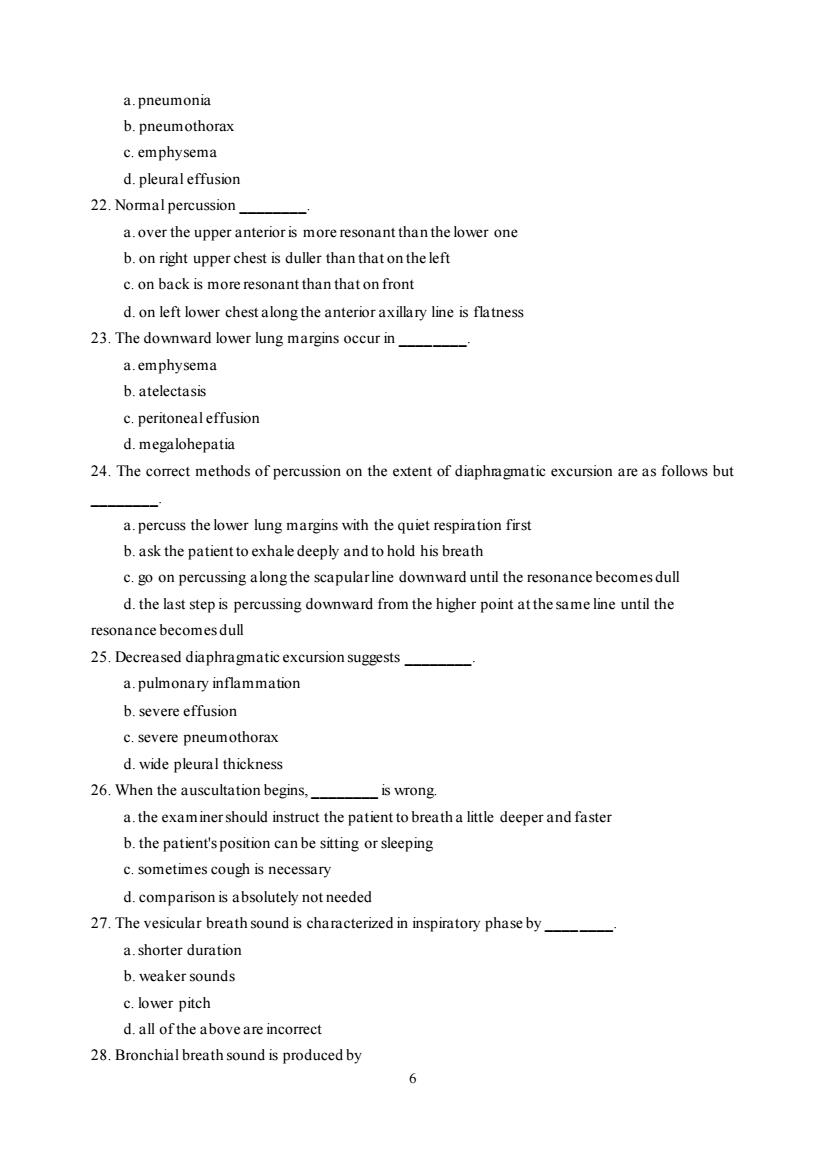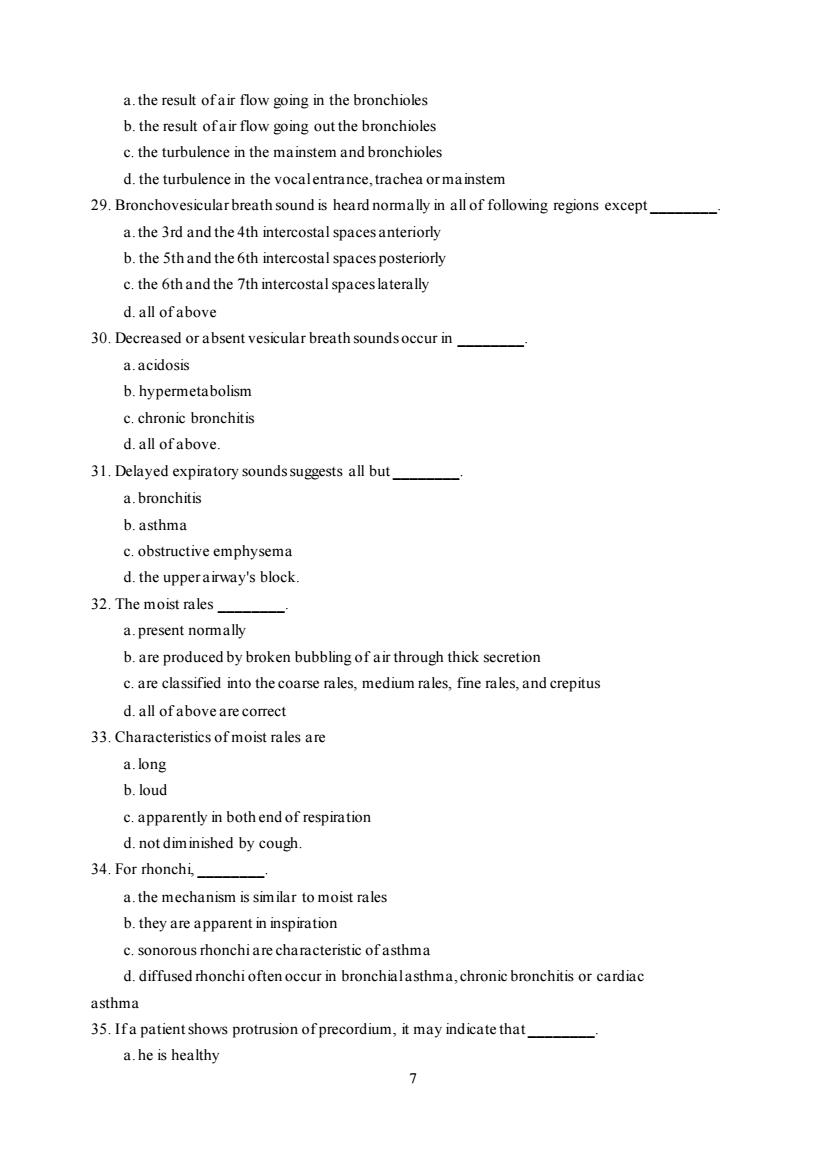
a.pneumonia b.pneumothorax c.emphysema d.pleuraleffusion 22.Nommalpercussion a.over the upper anterior is more resonant than the lower one b.on right upper chest is duller than that on the left c.on back is more resonant than that on front d.on left lower chest along the anterior axillary line is flatness 23.The downward lower lung margins occur in_ a.emphysema b.atelectasis d.megalohepatia 24.The correct methods of percussion on the extent of diaphragmatic excursion are as follows but a.percuss the lower lung margins with the quiet respiration first b.ask the patient to exhale deeply and to hold his breath e.go on percussing along the scapularline downward until the resonance becomesdull d.the last step is percussing downward from the higher point atthe same line until the resonance becomesdull 25.Decreased diaphragmatic excursion suggests a.pulmonary inflammation b.severe effusion c.severe pneumothorax d.wide pleural thickness 26.When the auscultation begins, is wrong a.the examiner should instruct the patient to breath a little deeper and faster b.the patient'sposition can be sitting or sleeping c.sometimes cough is necessary d.comparison is absolutely not needed 27.The vesicular breath sound is characterized in inspiratory phase by a.shorter duration b.weaker sounds c.lower pitch d.all of the above are incorrect 28.Bronchial breath sound is produced by 6
6 a. pneumonia b. pneumothorax c. emphysema d. pleural effusion 22. Normal percussion _. a. over the upper anterior is more resonant than the lower one b. on right upper chest is duller than that on the left c. on back is more resonant than that on front d. on left lower chest along the anterior axillary line is flatness 23. The downward lower lung margins occur in _. a. emphysema b. atelectasis c. peritoneal effusion d. megalohepatia 24. The correct methods of percussion on the extent of diaphragmatic excursion are as follows but _. a. percuss the lower lung margins with the quiet respiration first b. ask the patient to exhale deeply and to hold his breath c. go on percussing along the scapular line downward until the resonance becomes dull d. the last step is percussing downward from the higher point at the same line until the resonance becomes dull 25. Decreased diaphragmatic excursion suggests _. a. pulmonary inflammation b. severe effusion c. severe pneumothorax d. wide pleural thickness 26. When the auscultation begins, _ is wrong. a. the examiner should instruct the patient to breath a little deeper and faster b. the patient's position can be sitting or sleeping c. sometimes cough is necessary d. comparison is absolutely not needed 27. The vesicular breath sound is characterized in inspiratory phase by _ _. a. shorter duration b. weaker sounds c. lower pitch d. all of the above are incorrect 28. Bronchial breath sound is produced by

a.the result ofair flow going in the bronchioles b.the result ofair flow going out the bronchioles c.the turbulence in the mainstem and bronchioles d.the turbulence in the vocalentrance.trachea ormainstem 29.Bronchovesicularbreath sound is heard nommally in all of following regions except a.the 3rd and the 4th intercostal spacesanteriorly b.the 5thand the 6th intercostal spaces posteriorly c.the 6thand the 7th intercostal spaceslaterally d.all ofabove 30.Decreased or absent vesicular breath soundsoccur in a.acidosis b.hypermetabolism c.chronic bronchitis d.all ofabove. 31.Delayed expiratory soundssuggests all but a.bronchitis b.asthma c.obstructive emphysema d.the upperairway's block. 32.The moist rales a.present normally b.are produced by broken bubbling of air through thick secretion c.are classified into the coarse rales,medium rales,fine rales,and crepitus 33.Characteristics ofmoist rales are a.long b.loud c.apparently in bothendof respiration d.not diminished by cough 34.For rhonchi, a.the mechanism is similar to moist rales b.they are apparent in inspiration c.sonorous rhonchi are characteristic ofasthma d.diffused rhonchioftenoccur in bronchalasthma,chronic bronchitis or cardiac asthma 35.Ifa patientshows protrusion ofprecordium,it may indicate that a.he is healthy 7
7 a. the result of air flow going in the bronchioles b. the result of air flow going out the bronchioles c. the turbulence in the mainstem and bronchioles d. the turbulence in the vocal entrance, trachea or mainstem 29. Bronchovesicular breath sound is heard normally in all of following regions except _. a. the 3rd and the 4th intercostal spaces anteriorly b. the 5th and the 6th intercostal spaces posteriorly c. the 6th and the 7th intercostal spaces laterally d. all of above 30. Decreased or absent vesicular breath sounds occur in _. a. acidosis b. hypermetabolism c. chronic bronchitis d. all of above. 31. Delayed expiratory sounds suggests all but _. a. bronchitis b. asthma c. obstructive emphysema d. the upper airway's block. 32. The moist rales _. a. present normally b. are produced by broken bubbling of air through thick secretion c. are classified into the coarse rales, medium rales, fine rales, and crepitus d. all of above are correct 33. Characteristics of moist rales are a. long b. loud c. apparently in both end of respiration d. not diminished by cough. 34. For rhonchi, _. a. the mechanism is similar to moist rales b. they are apparent in inspiration c. sonorous rhonchi are characteristic of asthma d. diffused rhonchi often occur in bronchial asthma, chronic bronchitis or cardiac asthma 35. If a patient shows protrusion of precordium, it may indicate that _. a. he is healthy